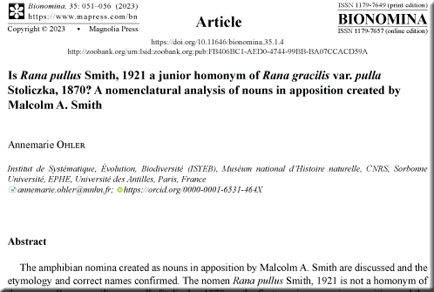Abstract
The amphibian nomina created as nouns in apposition by Malcolm A. Smith are discussed and the etymology and correct names confirmed. The nomen Rana pullus Smith, 1921 is not a homonym of the nomen Rana gracilis var. pulla Stoliczka, 1870, as the first one is a noun in apposition and the second an adjective, and they show more than a one-letter difference as required by the International Code of zoological Nomenclature. The valid name of the species currently known as Alcalus tasanae is therefore Alcalus pullus. Furthermore, the epithets of the following nomina are based on nouns in apposition and should be used accordingly: Megalophrys hasseltii var. pullus Smith, 1921, valid as Leptobrachium pullus; Megalophrys intermedius Smith, 1921, valid as Brachytarsophrys intermedius; Philautus gryllus Smith, 1924, valid as Kurixalus gryllus; Rana cancrivora raja Smith, 1930, invalid synonym of Fejervarya cancrivora; and Rana cataracta Smith, 1922, invalid synonym of Odorrana hosii. The importance to follow the Point 5 of the General Recommendations of the Appendix B of the Code, to state clearly the etymology of names, is highlighted.
References
- Anonymous [International Commission on Zoological Nomenclature] (1999) International code of zoological nomenclature. ‘Fourth edition’. London (International Trust for zoological Nomenclature): i–xxix + 1–306.
- Barbour, T. & Loveridge, A. (1929) Typical reptiles and amphibians. Bulletin of the Museum of comparative Zoology, 69: 205–360.
- Bourret, R. (1939) Notes herpétologiques sur l’Indochine française. XX. Liste des reptiles et batraciens actuellement connus en Indochine Française. Annexe au Bulletin général de l’Instruction publique, Hanoi, 1939: 49–60.
- Bourret, R. (1942) Les Batraciens de l’Indochine. Hanoi (Institut océanographique de l’Indochine): i–x + 1–547, 4 plates.
- Brown, R. M., Siler, C. D., Richards, S. J., Diesmos, A. C. & Cannatella, D. C. (2015) Multilocus phylogeny and a new classification for southeast Asian and Melanesian forest frogs (family Ceratobatrachidae). Zoological Journal of the Linnean Society, 174: 130–168. <https://doi.org/10.1111/zoj.12232>.
- Dubois, A. (1987) Miscellanea taxinomica batrachologica (I). Alytes, 5: 7–95.
- Dubois, A., Bauer, A. M., Ceríaco, L. M. P., Dusoulier, F., Frétey, T., Löbl, I., Lorvelec, O., Ohler, A., Stopiglia, R. & Aescht, E. (2019) The Linz Zoocode project: a set of new proposals regarding the terminology, the Principles and Rules of zoological nomenclature. First report of activities (2014‒2019). Bionomina, 17: 1‒111. <https://doi.org/10.11646/bionomina.17.1.1>.
- Frétey, T. (2019) Capitalised epithets in the works of Linnaeus (1758‒1767): findings and consequences in herpetology. Bionomina, 16: 22–45. <https://doi.org/10.11646/bionomina.16.1.2>.
- Inger, R. F. (1966) The systematics and zoogeography of the Amphibia of Borneo. Fieldiana: Zoology, 52: 1–402. <https://doi.org/10.5962/bhl.title.3147>.
- Mahony, S., Foley, N. M., Biju, S. D. & Teeling, E. C. (2017) Evolutionary history of the Asian horned frogs (Megophryinae): integrative approaches to timetree dating in the absence of a fossil record. Molecular Biology and Evolution, 34: 744–771. <https://doi.org/10.1093/molbev/msw267>.
- Orlov, N. L., Murphy, R. W., Ananjeva, N. B., Ryabov, S. A. & Cuc, H. T. (2002) Herpetofauna of Vietnam, a checklist. Part 1. Amphibia. Russian Journal of Herpetology, 9: 81–104.
- Rao, D.-Q. & Yang, D.-T. (1997) The variation in karyotypes of Brachytarsophrys from China with a discussion of the classification of the genus. Asiatic herpetological Research, 7: 103–107. <https://doi.org/10.5962/bhl.part.18859>.
- Smith, M. A. (1921a) New or little-known reptiles and batrachians from southern Annam (Indo-China). Proceedings of the zoological Society of London, 1921: 423–440. <https://doi.org/10.1111/j.1096-3642.1921.tb03271.x>.
- Smith, M. A. (1921b) Two new batrachians and a new snake from Borneo and the Malay Peninsula. Journal of the Federated Malay States Museum, 10: 197–199, plate 2.
- Smith, M. A. (1921c) A new name for the frog Rana pullus. Journal of the natural History Society of Siam, 4: 193.
- Smith, M. A. (1922) On a collection of reptiles and batrachians from the mountains of Pahang, Malay Peninsula. Journal of the Federated Malay States Museums, 10: 263–282.
- Smith, M.A. (1924) New tree-frogs from Indo-China and the Malay Peninsula. Proceedings of the zoological Society of London, 1924: 225–235, 3 plates. <https://doi.org/10.1111/j.1096-3642.1924.tb01499.x>.
- Smith, M. A. 1930. The Reptilia and Amphibia of the Malay Peninsula. A supplement to G. A. Boulenger’s Reptilia and Batrachia, 1912. Bulletin of the Raffles Museum, 3: i–xviii + 1–149.
- Stoliczka, F. (1870) Observations on some Indian and Malayan Amphibia and Reptilia. Journal of the Asiatic Society of Bengal, 39: 134–157, plate 9.
- Taylor, E. H. (1962) The amphibian fauna of Thailand. University of Kansas Science Bulletin, 43: 265–599. <https://doi.org/10.5962/bhl.part.13347>.
- Yodthong, S., Stuart, B. L. & Aowphol, A. (2019) Species delimitation of crab-eating frogs (Fejervarya cancrivora complex) clarifies taxonomy and geographic distributions in mainland southeast Asia. ZooKeys, 883: 119–153. .


